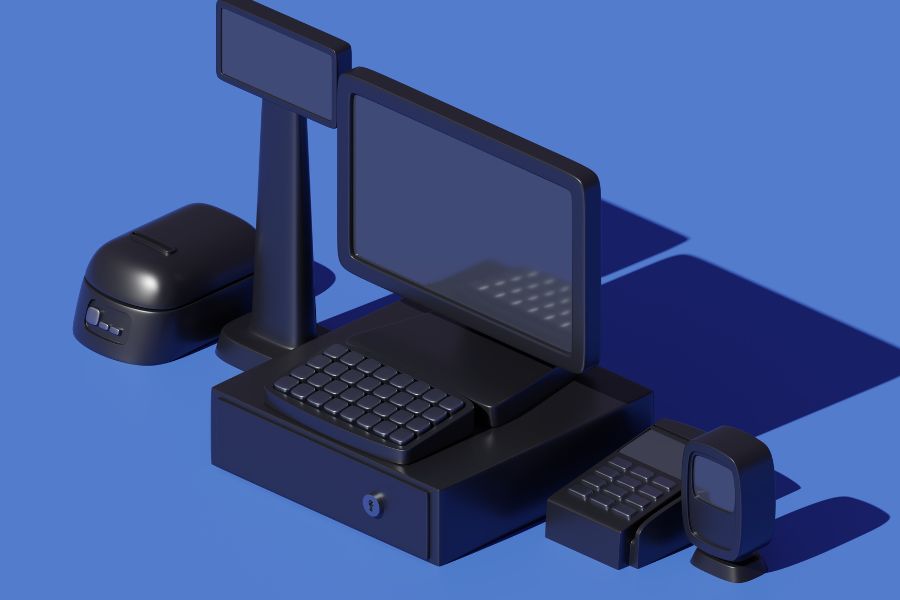As consumer preferences evolve, retailers are expanding their product offerings to cater to diverse demands, often creating complexities in stock management. Traditional inventory methods, while once reliable, struggle to keep pace with the rapid shifts in modern retail. This inefficiency can lead to costly mistakes such as overstocking, stockouts, and missed opportunities for optimization. In this landscape, adopting an inventory POS system provides a solution by integrating real-time tracking and automation directly into sales processes. This article explores common inventory management methods, the challenges they face in today’s retail world, and how POS systems can streamline operations while minimizing costs and risks.
Highlights:
- Traditional inventory systems often struggle with inefficiencies, inaccurate data, and lack of real-time visibility, leading to costly stockouts or overstocking.
- An inventory POS system improves accuracy, automates stock tracking, and integrates sales and inventory data, helping businesses reduce operational costs and risks.
Popular Inventory Management Methods Used by Retailers
Retailers employ various strategies to manage inventory, each with distinct benefits and limitations:
Periodic Inventory Systems
This traditional approach involves manually counting stock at set intervals, such as monthly or quarterly. While straightforward and cost-effective, it often lacks accuracy between counts, leaving retailers susceptible to inventory mismatches and missed sales opportunities.
Perpetual Inventory Systems
These systems leverage technology to track inventory in real-time, updating stock levels with each sale or restock. Though highly accurate, perpetual systems require a significant initial investment in software and training.
Spreadsheet-Based Management
Small to mid-sized retailers often rely on spreadsheets for their inventory tracking. While affordable, this method is prone to human error, tedious manual updates, and difficulties scaling with business growth.
Barcode and RFID Systems
Barcode scanning and RFID technology streamline inventory processes by automating stock entry and tracking. However, they can be cost-prohibitive for smaller businesses and require ongoing maintenance to stay effective.
►►► Optimal solution set for businesses: Multi store POS, Next-gen POS, Inventory Management Software (MSI), Self Service, Automation, Backorders
Each of these methods offers unique advantages, but as retail grows more complex, limitations become increasingly evident.
New Challenges for Legacy Inventory Management Amid Modern Retail
The retail industry is evolving, bringing challenges that outdated inventory systems struggle to address:
Omni-Channel Operations
Managing stock across multiple channels, including brick-and-mortar stores, online shops, and mobile platforms, demands precise, synchronized data. Legacy methods often fail to provide real-time updates, leading to stock inconsistencies that frustrate customers.
Heightened Customer Expectations
Today’s shoppers demand accurate inventory visibility and fast delivery. Errors or delays in stock management can result in customer dissatisfaction and reduced loyalty.
Manual Workflows
Many traditional systems rely heavily on manual processes, increasing the likelihood of errors, inefficiencies, and wasted labor hours. These challenges escalate as inventory grows in size or complexity.
Regulatory Adjustments
Retailers must adapt to ever-changing tax regulations, sustainability initiatives, and labeling requirements. Outdated systems often lack the flexibility to meet these demands.
Growth and Scalability
As businesses expand, older inventory management methods often struggle to scale efficiently, creating bottlenecks in operations and limiting growth potential.
Faced with these challenges, more retailers are turning to modern solutions like inventory POS systems to stay competitive and efficient.
How Inventory POS Systems Reduce Your Operation Costs and Risks
An inventory POS system goes beyond basic sales tracking by integrating inventory management into every transaction. This technology helps retailers streamline processes, minimize errors, and improve decision-making, ultimately cutting costs and mitigating risks. Here’s how:
Real-Time Inventory Tracking
Inventory POS systems provide immediate updates as products are sold or restocked. This eliminates the delays of manual recording and ensures that stock levels are always accurate, helping to avoid overstocking or stockouts, which can be costly.
Reduced Labor Costs
Automation reduces the need for manual inventory counts and data entry. Staff can focus on more value-driven tasks, cutting down on labor expenses while improving productivity across operations.
Improved Accuracy
By reducing human involvement in stock updates and using tools like barcode scanning, inventory POS systems significantly lower the risk of errors. Accurate data prevents costly mistakes, such as reordering products that are already in stock or missing reorders for popular items.
Enhanced Inventory Planning
The system analyzes historical sales data to predict demand trends. This allows businesses to stock efficiently, reducing waste from unsold products and ensuring customer needs are consistently met.
Omni-Channel Integration
For retailers operating across multiple platforms, an inventory POS system synchronizes data from all channels. This ensures consistent stock visibility and availability, reducing the risk of disappointing customers due to discrepancies.
Scalability for Growth
As businesses grow, managing inventory becomes more complex. Inventory POS systems are designed to handle increasing product ranges, sales channels, and locations, allowing retailers to scale their operations without additional complexity.
Compliance and Reporting
Many inventory POS systems include features to generate detailed reports and comply with local regulations. This minimizes risks related to tax errors or compliance violations, protecting businesses from penalties.
Steps to Implement a New Inventory POS System
Adopting an inventory POS system is a strategic process that demands preparation and structured execution to achieve seamless integration and long-term benefits.
1. Evaluate Your Business Needs
Begin by identifying operational bottlenecks such as manual inventory tracking inefficiencies, slow restocking processes, or lack of visibility across sales channels. For example, multi-location businesses may need robust inventory synchronization, while small retailers might prioritize ease of use. This evaluation ensures the selected system addresses your unique challenges.
2. Research and Compare Solutions
Look for systems with features that match your requirements. Focus on solutions that integrate well with existing tools, provide scalability, and offer strong customer support. For instance, ConnectPOS combines advanced inventory management, mobile POS, and CRM features, making it a versatile choice for businesses of all sizes.
3. Develop a Clear Implementation Plan
Work with your chosen vendor to create a step-by-step plan, including timelines for data migration, employee training, and testing. Outline key milestones and assign roles to ensure accountability throughout the process.
4. Prepare and Migrate Your Data
Audit and clean your current inventory data to remove errors or duplicates before transferring it into the new system. Ensure accurate information for product descriptions, SKUs, and quantities. A smooth migration reduces discrepancies and sets a solid foundation for the new system.
5. Train Your Team Thoroughly
Conduct in-depth training sessions tailored to your team’s roles. Frontline employees should learn daily operational tasks, while managers should focus on generating reports and analyzing data. Reinforce training with user manuals or access to vendor resources like online tutorials or live support.
6. Run a Pilot Test
Test the system in a controlled environment before a full rollout. Simulate common scenarios, such as peak sales periods or inventory restocking, to identify potential issues. This phase helps fine-tune the configuration and ensures that the system works as expected in real-world conditions.
7. Launch the System Gradually
Roll out the new system incrementally, starting with a single location or department if possible. Monitor its performance closely and gather feedback from employees and customers to address any initial challenges.
8. Monitor, Optimize, and Maintain
Regularly review system performance and make adjustments as needed. Use the system’s analytics tools to track key metrics such as inventory turnover rates, stock discrepancies, and sales trends. Schedule updates and maintenance to keep the system running efficiently and securely.
ConnectPOS: A Smart Choice for Retailers
If you’re searching for a solution that simplifies inventory management, customer relationship building, and on-the-go sales, ConnectPOS stands out as a smart choice. Its real-time inventory tracking ensures accurate stock levels across all channels, reducing errors and preventing costly stockouts or overstocks. The system supports multi-location management, allowing businesses to monitor inventory, sales, and operations from a centralized platform.
ConnectPOS also provides an intuitive CRM feature that helps retailers understand customer preferences and build loyalty through personalized services. Its mobile POS capabilities let your team process transactions and assist customers anywhere, improving the shopping experience. With built-in analytics, ConnectPOS delivers actionable insights on sales performance and inventory trends, helping retailers refine their strategies.
FAQs: Inventory POS System
- What are the key benefits of using an inventory POS system for retail?
An inventory POS system provides real-time stock tracking, reduces manual errors, supports multi-location management, and integrates with CRM tools to enhance customer engagement while streamlining operations.
- Can inventory POS systems be customized for specific business needs?
Yes, many inventory POS systems offer customizable features, allowing businesses to tailor stock management, reporting, and integrations to meet their unique operational requirements.
- What should I consider before implementing a new inventory POS system?
Key considerations include compatibility with existing software, scalability to support business growth, ease of use for your staff, and features like mobile POS and real-time analytics.
Conclusion
Retailers today face increasing challenges in managing inventory, especially as customer expectations and market dynamics shift rapidly. An inventory POS system addresses these challenges by simplifying stock tracking, reducing risks, and cutting unnecessary expenses. By unifying inventory, sales, and customer data, this technology helps businesses stay agile and prepared for future growth.
If you’re ready to elevate your retail operations, ConnectPOS offers a feature-rich platform designed for modern needs. From real-time inventory updates to mobile POS functionality and customer relationship tools, it provides everything you need to stay competitive. Contact us and take the first step toward smarter retail management with ConnectPOS!
►►► Optimal solution set for businesses: Shopify POS, Magento POS, BigCommerce POS, WooCommerce POS, NetSuite POS, E-Commerce POS



